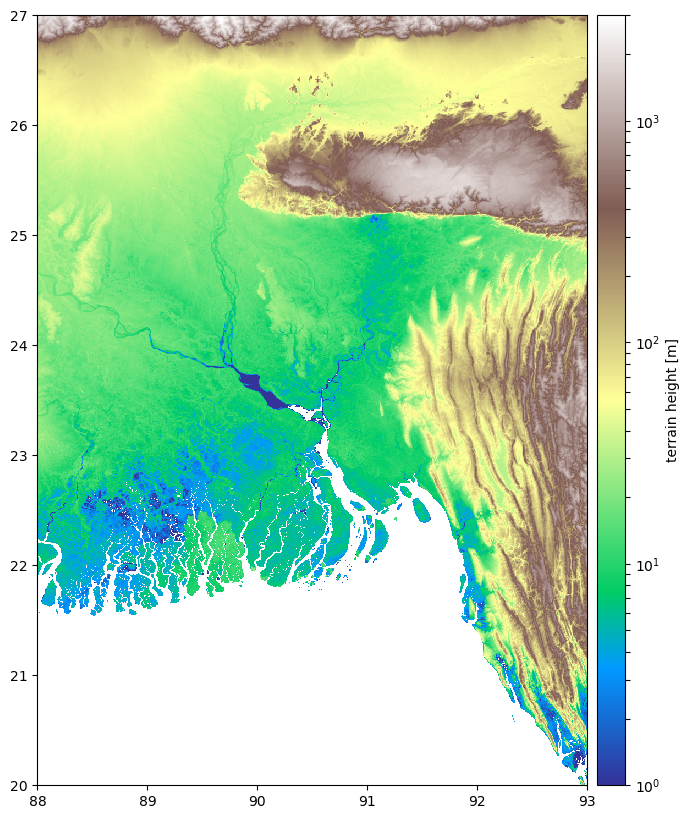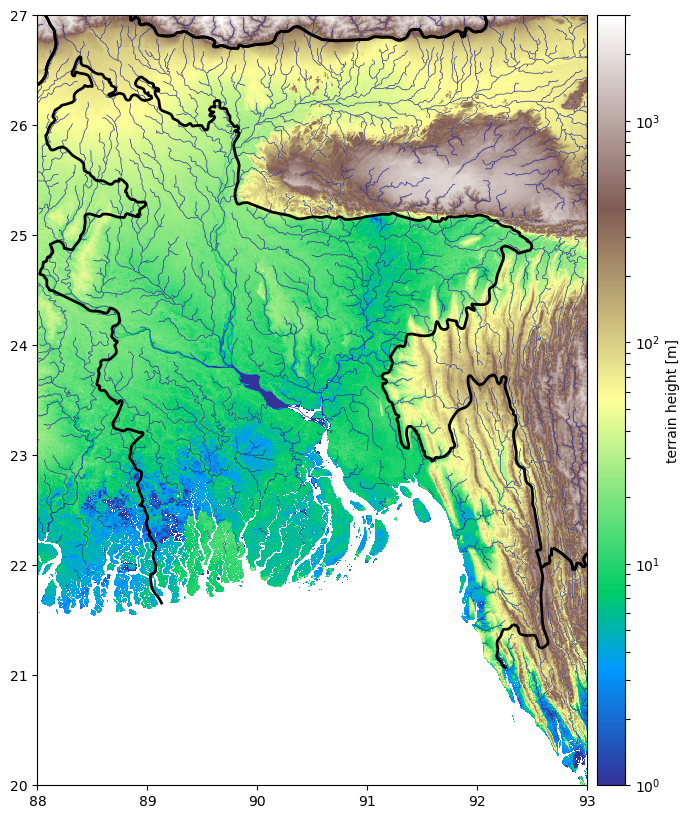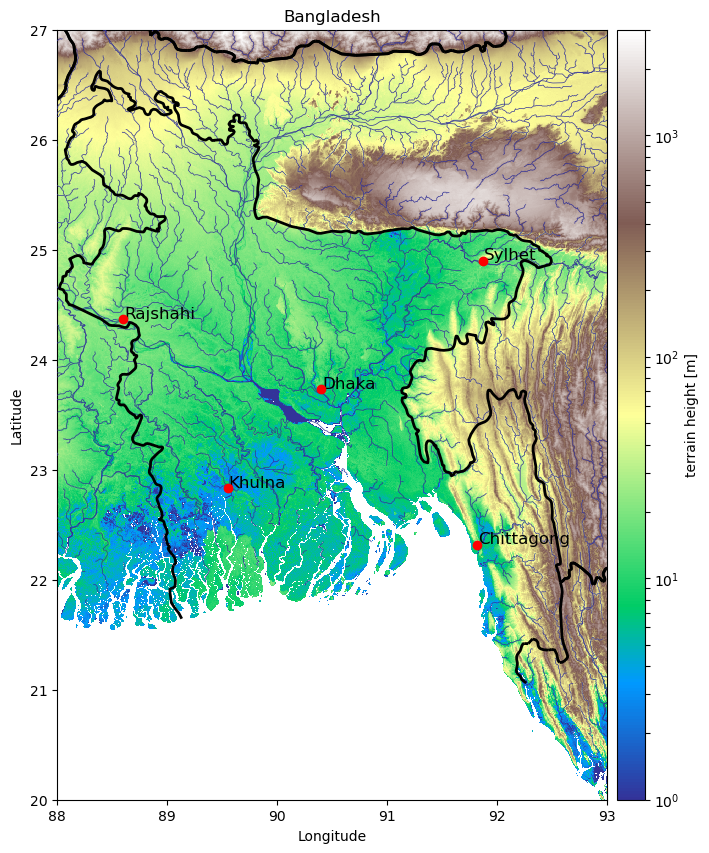Plot geodata#
underlay e.g. terrain data from a Digital Elevation Model (DEM)
overlay features such as administrative borders, rivers, catchments, rain gauges, cities, …
Here, we create a map without radar data to concentrate on the other layers.
[1]:
import wradlib as wrl
import matplotlib.pyplot as pl
import warnings
warnings.filterwarnings("ignore")
try:
get_ipython().run_line_magic("matplotlib inline")
except:
pl.ion()
import numpy as np
# Some more matplotlib tools we will need...
import matplotlib.ticker as ticker
from matplotlib.colors import LogNorm
from mpl_toolkits.axes_grid1 import make_axes_locatable
/home/runner/micromamba-root/envs/wradlib-tests/lib/python3.11/site-packages/tqdm/auto.py:22: TqdmWarning: IProgress not found. Please update jupyter and ipywidgets. See https://ipywidgets.readthedocs.io/en/stable/user_install.html
from .autonotebook import tqdm as notebook_tqdm
Plotting a Digital Elevation Model (DEM)#
We use a preprocessed geotiff which was created from SRTM data via gdal
gdalwarp -te 88. 20. 93. 27. srtm_54_07.tif srtm_55_07.tif srtm_54_08.tif srtm_55_08.tif bangladesh.tif
Here we - read the DEM via wradlib.io.open_raster and extracted via wradlib.georef.extract_raster_dataset. - resample the data to a (lon/lat) grid with spacing=0.005.
Note: we organise the code in functions which we can re-use in this notebook.
[2]:
def plot_dem(ax):
filename = wrl.util.get_wradlib_data_file("geo/bangladesh.tif")
ds = wrl.io.open_raster(filename)
# pixel_spacing is in output units (lonlat)
ds = wrl.georef.reproject_raster_dataset(ds, spacing=0.005)
rastervalues, rastercoords, proj = wrl.georef.extract_raster_dataset(ds)
# specify kwargs for plotting, using terrain colormap and LogNorm
dem = ax.pcolormesh(
rastercoords[..., 0],
rastercoords[..., 1],
rastervalues,
cmap=pl.cm.terrain,
norm=LogNorm(vmin=1, vmax=3000),
)
# make some space on the right for colorbar axis
div1 = make_axes_locatable(ax)
cax1 = div1.append_axes("right", size="5%", pad=0.1)
# add colorbar and title
# we use LogLocator for colorbar
cb = pl.gcf().colorbar(dem, cax=cax1, ticks=ticker.LogLocator(subs=range(10)))
cb.set_label("terrain height [m]")
[3]:
fig = pl.figure(figsize=(10, 10))
ax = fig.add_subplot(111, aspect="equal")
plot_dem(ax)
Downloading file 'geo/bangladesh.tif' from 'https://github.com/wradlib/wradlib-data/raw/pooch/data/geo/bangladesh.tif' to '/home/runner/work/wradlib/wradlib/wradlib-data'.

Plotting borders#
For country borders, we use ESRI Shapfiles from Natural Earth Data.
We extract features using - the OGR.Layer AttributeFilter and - the wradlib.georef.get_vector_coordinates function.
The plot overlay is done via wradlib.vis.add_lines.
[4]:
flist = [
"geo/ne_10m_admin_0_boundary_lines_land.shx",
"geo/ne_10m_admin_0_boundary_lines_land.prj",
"geo/ne_10m_admin_0_boundary_lines_land.dbf",
]
[wrl.util.get_wradlib_data_file(f) for f in flist]
def plot_borders(ax):
# country list
countries = ["India", "Nepal", "Bhutan", "Myanmar"]
# open the input data source and get the layer
filename = wrl.util.get_wradlib_data_file(
"geo/ne_10m_admin_0_boundary_lines_land.shp"
)
dataset, inLayer = wrl.io.open_vector(filename)
# iterate over countries, filter accordingly, get coordinates and plot
for item in countries:
# SQL-like selection syntax
fattr = "(adm0_left = '" + item + "' or adm0_right = '" + item + "')"
inLayer.SetAttributeFilter(fattr)
# get borders and names
borders, keys = wrl.georef.get_vector_coordinates(inLayer, key="name")
wrl.vis.add_lines(ax, borders, color="black", lw=2, zorder=4)
ax.autoscale()
Downloading file 'geo/ne_10m_admin_0_boundary_lines_land.shx' from 'https://github.com/wradlib/wradlib-data/raw/pooch/data/geo/ne_10m_admin_0_boundary_lines_land.shx' to '/home/runner/work/wradlib/wradlib/wradlib-data'.
Downloading file 'geo/ne_10m_admin_0_boundary_lines_land.prj' from 'https://github.com/wradlib/wradlib-data/raw/pooch/data/geo/ne_10m_admin_0_boundary_lines_land.prj' to '/home/runner/work/wradlib/wradlib/wradlib-data'.
Downloading file 'geo/ne_10m_admin_0_boundary_lines_land.dbf' from 'https://github.com/wradlib/wradlib-data/raw/pooch/data/geo/ne_10m_admin_0_boundary_lines_land.dbf' to '/home/runner/work/wradlib/wradlib/wradlib-data'.
[5]:
fig = pl.figure(figsize=(10, 10))
ax = fig.add_subplot(111, aspect="equal")
plot_dem(ax)
plot_borders(ax)
ax.set_xlim((88, 93))
ax.set_ylim((20, 27))
Downloading file 'geo/ne_10m_admin_0_boundary_lines_land.shp' from 'https://github.com/wradlib/wradlib-data/raw/pooch/data/geo/ne_10m_admin_0_boundary_lines_land.shp' to '/home/runner/work/wradlib/wradlib/wradlib-data'.
[5]:
(20.0, 27.0)

Plotting Rivers#
For rivers, we use ESRI Shapfiles from FAO and Natural Earth Data.
We extract features using - the OGR.Layer SpatialFilter and - the wradlib.georef.get_vector_coordinates function.
Then we use wradlib.vis.add_lines again for the overlay.
[6]:
flist = [
"geo/rivers_asia_37331.shx",
"geo/rivers_asia_37331.prj",
"geo/rivers_asia_37331.dbf",
]
[wrl.util.get_wradlib_data_file(f) for f in flist]
def plot_rivers(ax):
# plot rivers from esri vector shape, filter spatially
# http://www.fao.org/geonetwork/srv/en/metadata.show?id=37331
# open the input data source and get the layer
filename = wrl.util.get_wradlib_data_file("geo/rivers_asia_37331.shp")
dataset, inLayer = wrl.io.open_vector(filename)
# do spatial filtering to get only geometries inside bounding box
inLayer.SetSpatialFilterRect(88, 20, 93, 27)
rivers, keys = wrl.georef.get_vector_coordinates(inLayer, key="MAJ_NAME")
# plot on ax1, and ax4
wrl.vis.add_lines(ax, rivers, color=pl.cm.terrain(0.0), lw=0.5, zorder=3)
Downloading file 'geo/rivers_asia_37331.shx' from 'https://github.com/wradlib/wradlib-data/raw/pooch/data/geo/rivers_asia_37331.shx' to '/home/runner/work/wradlib/wradlib/wradlib-data'.
Downloading file 'geo/rivers_asia_37331.prj' from 'https://github.com/wradlib/wradlib-data/raw/pooch/data/geo/rivers_asia_37331.prj' to '/home/runner/work/wradlib/wradlib/wradlib-data'.
Downloading file 'geo/rivers_asia_37331.dbf' from 'https://github.com/wradlib/wradlib-data/raw/pooch/data/geo/rivers_asia_37331.dbf' to '/home/runner/work/wradlib/wradlib/wradlib-data'.
[7]:
fig = pl.figure(figsize=(10, 10))
ax = fig.add_subplot(111, aspect="equal")
plot_dem(ax)
plot_borders(ax)
plot_rivers(ax)
ax.set_xlim((88, 93))
ax.set_ylim((20, 27))
Downloading file 'geo/rivers_asia_37331.shp' from 'https://github.com/wradlib/wradlib-data/raw/pooch/data/geo/rivers_asia_37331.shp' to '/home/runner/work/wradlib/wradlib/wradlib-data'.
[7]:
(20.0, 27.0)

[8]:
flist = [
"geo/ne_10m_rivers_lake_centerlines.shx",
"geo/ne_10m_rivers_lake_centerlines.prj",
"geo/ne_10m_rivers_lake_centerlines.dbf",
]
[wrl.util.get_wradlib_data_file(f) for f in flist]
def plot_water(ax):
# plot rivers from esri vector shape, filter spatially
# plot rivers from NED
# open the input data source and get the layer
filename = wrl.util.get_wradlib_data_file("geo/ne_10m_rivers_lake_centerlines.shp")
dataset, inLayer = wrl.io.open_vector(filename)
inLayer.SetSpatialFilterRect(88, 20, 93, 27)
rivers, keys = wrl.georef.get_vector_coordinates(inLayer)
wrl.vis.add_lines(ax, rivers, color=pl.cm.terrain(0.0), lw=0.5, zorder=3)
Downloading file 'geo/ne_10m_rivers_lake_centerlines.shx' from 'https://github.com/wradlib/wradlib-data/raw/pooch/data/geo/ne_10m_rivers_lake_centerlines.shx' to '/home/runner/work/wradlib/wradlib/wradlib-data'.
Downloading file 'geo/ne_10m_rivers_lake_centerlines.prj' from 'https://github.com/wradlib/wradlib-data/raw/pooch/data/geo/ne_10m_rivers_lake_centerlines.prj' to '/home/runner/work/wradlib/wradlib/wradlib-data'.
Downloading file 'geo/ne_10m_rivers_lake_centerlines.dbf' from 'https://github.com/wradlib/wradlib-data/raw/pooch/data/geo/ne_10m_rivers_lake_centerlines.dbf' to '/home/runner/work/wradlib/wradlib/wradlib-data'.
[9]:
fig = pl.figure(figsize=(10, 10))
ax = fig.add_subplot(111, aspect="equal")
plot_dem(ax)
plot_borders(ax)
plot_rivers(ax)
plot_water(ax)
ax.set_xlim((88, 93))
ax.set_ylim((20, 27))
Downloading file 'geo/ne_10m_rivers_lake_centerlines.shp' from 'https://github.com/wradlib/wradlib-data/raw/pooch/data/geo/ne_10m_rivers_lake_centerlines.shp' to '/home/runner/work/wradlib/wradlib/wradlib-data'.
[9]:
(20.0, 27.0)

Plotting Cities#
The 5 biggest cities of bangladesh are added using simple matplotlib functions.
[10]:
def plot_cities(ax):
# plot city dots with annotation, finalize plot
# lat/lon coordinates of five cities in Bangladesh
lats = [23.73, 22.32, 22.83, 24.37, 24.90]
lons = [90.40, 91.82, 89.55, 88.60, 91.87]
cities = ["Dhaka", "Chittagong", "Khulna", "Rajshahi", "Sylhet"]
for lon, lat, city in zip(lons, lats, cities):
ax.plot(lon, lat, "ro", zorder=5)
ax.text(lon + 0.01, lat + 0.01, city, fontsize="large")
[11]:
fig = pl.figure(figsize=(10, 10))
ax = fig.add_subplot(111, aspect="equal")
plot_dem(ax)
plot_borders(ax)
plot_rivers(ax)
plot_water(ax)
plot_cities(ax)
ax.set_xlim((88, 93))
ax.set_ylim((20, 27))
ax.set_xlabel("Longitude")
ax.set_ylabel("Latitude")
ax.set_aspect("equal")
ax.set_title("Bangladesh")
[11]:
Text(0.5, 1.0, 'Bangladesh')

Plotting country patches#
Plotting in “geographic projection” (WGS84)#
Here, we plot countries as patches on a lat/lon (WGS84) map (data from Natural Earth Data again).
We again extract the features using - the OGR.Layer SpatialFilter and - wradlib.georef.get_vector_coordinates.
Then the patches are added one by one via wradlib.vis.add_patches.
[12]:
flist = [
"geo/ne_10m_admin_0_countries.shx",
"geo/ne_10m_admin_0_countries.prj",
"geo/ne_10m_admin_0_countries.dbf",
]
[wrl.util.get_wradlib_data_file(f) for f in flist]
def plot_wgs84(ax):
from osgeo import osr
wgs84 = osr.SpatialReference()
wgs84.ImportFromEPSG(4326)
# some testing on additional axes
# add Bangladesh to countries
countries = ["India", "Nepal", "Bhutan", "Myanmar", "Bangladesh"]
# create colors for country-patches
cm = pl.cm.jet
colors = []
for i in range(len(countries)):
colors.append(cm(1.0 * i / len(countries)))
# open the input data source and get the layer
filename = wrl.util.get_wradlib_data_file("geo/ne_10m_admin_0_countries.shp")
dataset, layer = wrl.io.open_vector(filename)
# filter spatially and plot as PatchCollection on ax3
layer.SetSpatialFilterRect(88, 20, 93, 27)
patches, keys = wrl.georef.get_vector_coordinates(layer, dest_srs=wgs84, key="name")
i = 0
for name, patch in zip(keys, patches):
# why comes the US in here?
if name in countries:
wrl.vis.add_patches(
ax, patch, facecolor=colors[i], cmap=pl.cm.viridis, alpha=0.4
)
i += 1
ax.autoscale(True)
ax.set_aspect("equal")
ax.set_xlabel("Longitude")
ax.set_ylabel("Latitude")
ax.set_title("South Asia - WGS 84")
Downloading file 'geo/ne_10m_admin_0_countries.shx' from 'https://github.com/wradlib/wradlib-data/raw/pooch/data/geo/ne_10m_admin_0_countries.shx' to '/home/runner/work/wradlib/wradlib/wradlib-data'.
Downloading file 'geo/ne_10m_admin_0_countries.prj' from 'https://github.com/wradlib/wradlib-data/raw/pooch/data/geo/ne_10m_admin_0_countries.prj' to '/home/runner/work/wradlib/wradlib/wradlib-data'.
Downloading file 'geo/ne_10m_admin_0_countries.dbf' from 'https://github.com/wradlib/wradlib-data/raw/pooch/data/geo/ne_10m_admin_0_countries.dbf' to '/home/runner/work/wradlib/wradlib/wradlib-data'.
[13]:
fig = pl.figure(figsize=(10, 10))
ax = fig.add_subplot(111, aspect="equal")
plot_wgs84(ax)
Downloading file 'geo/ne_10m_admin_0_countries.shp' from 'https://github.com/wradlib/wradlib-data/raw/pooch/data/geo/ne_10m_admin_0_countries.shp' to '/home/runner/work/wradlib/wradlib/wradlib-data'.

Plotting with a map projection#
Here, we plot countries as patches on a projected map.
We extract the features using - the OGR.Layer AttributeFilter and - the wradlib.georef.get_vector_coordinates function.
The coordinates of the features are reprojected on the fly using the dest_srs keyword of wradlib.georef.get_vector_coordinates.
Then, the patches are added to the map via wradlib.vis.add_patches.
[14]:
def plot_mercator(ax):
from osgeo import osr
proj = osr.SpatialReference()
# "Web Mercator" projection (used by GoogleMaps, OSM, ...)
proj.ImportFromEPSG(3857)
# add Bangladesh to countries
countries = ["India", "Nepal", "Bhutan", "Myanmar", "Bangladesh"]
# create colors for country-patches
cm = pl.cm.jet
colors = []
for i in range(len(countries)):
colors.append(cm(1.0 * i / len(countries)))
# open the input data source and get the layer
filename = wrl.util.get_wradlib_data_file("geo/ne_10m_admin_0_countries.shp")
dataset, layer = wrl.io.open_vector(filename)
# iterate over countries, filter by attribute,
# plot single patches on ax2
for i, item in enumerate(countries):
fattr = "name = '" + item + "'"
layer.SetAttributeFilter(fattr)
# get country patches and geotransform to destination srs
patches, keys = wrl.georef.get_vector_coordinates(
layer, dest_srs=proj, key="name"
)
wrl.vis.add_patches(pl.gca(), patches, facecolor=colors[i])
ax.autoscale(True)
ax.set_aspect("equal")
ax.set_xlabel("X - Coordinate")
ax.set_ylabel("Y - Coordinate")
ax.ticklabel_format(style="sci", scilimits=(0, 0))
ax.set_title("South Asia in Web Mercator Projection ")
[15]:
fig = pl.figure(figsize=(10, 10))
ax = fig.add_subplot(111, aspect="equal")
plot_mercator(ax)

